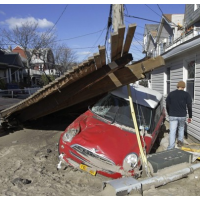25 Billion-Dollar Disasters in U.S. in Two Years
 Rockaways neighborhood, N.Y., post-Sandy (photo: Kathy Willens, AP)
Rockaways neighborhood, N.Y., post-Sandy (photo: Kathy Willens, AP)
Extreme weather has really taken its toll on the United States in recent years, with more than two dozen natural disasters that each cost $1 billion or more.
During 2011 and 2012, 25 billion-dollar floods, storms, droughts, heat waves and wildfires were unleashed in the U.S., killing 1,107 individuals and causing $188 billion in economic damages.
Superstorm Sandy alone killed 72 and wreaked nearly $50 billion in destruction. The federal government pitched in more than $60 billion in disaster relief and recovery funds.
The Center for American Progress calculated that the federal government spent $136 billion on disaster relief between 2011 and 2013, which amounts to about $400 per year for each U.S. household. Of the total, $55.4 billion came from the Department of Homeland Security and $36.4 billion from the Department of Agriculture.
The center noted that warming air and water temperatures due to climate change have increased the severity and frequency of extreme weather events. The group cited information compiled by the National Oceanic and Atmospheric Administration, which showed the U.S. experienced the second-highest amount of extreme weather on record in 2012. They recommended that the government spend more money on helping communities prepare for disasters or, in governmentese, “pre-disaster mitigation,” spending for which has actually declined over the past decade.
-Noel Brinkerhoff, David Wallechinsky
To Learn More:
Disastrous Spending: Federal Disaster-Relief Expenditures Rise amid More Extreme Weather (by Daniel J. Weiss and Jackie Weidman, Center for American Progress)
5 California House Republicans Voted to Help Victims of Katrina, but Not Sandy (by Ken Broder, AllGov California)
As Hurricane Sandy Hits East Coast, Romney and Ryan Reiterate Their Aim to Privatize FEMA (by Noel Brinkerhoff, AllGov)
Obama Asks $59 Billion in Extra Spending for Disaster Relief, Haiti, Agent Orange Disabilities and…War (by Noel Brinkerhoff, AllGov)
- Top Stories
- Unusual News
- Where is the Money Going?
- Controversies
- U.S. and the World
- Appointments and Resignations
- Latest News
- Musk and Trump Fire Members of Congress
- Trump Calls for Violent Street Demonstrations Against Himself
- Trump Changes Name of Republican Party
- The 2024 Election By the Numbers
- Bashar al-Assad—The Fall of a Rabid AntiSemite






Comments